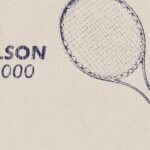The double-strung spaghetti racket – Legendary Racquets #4
Some tennis racquets are memorable; some stick in the mind for even longer. Only a few are truly iconic. Seb Proisy presents them in the new Tennis Majors video series. In this fourth episode, he discusses the double-strung spaghetti stringing method that became popular in 1977.
In this day and age, every player in professional tennis uses the same stringing pattern and just about all of them use polyester string. Whatever the case, string is never going to be the difference in a tournament or even in a single match. In terms of string, the playing field is level.
But it wasn’t always this way.
For a brief time more than 40 years ago, the way a player strung his or her racket had the potential to be a major factor. One of the more interesting – and effective – methods was the double-strung spaghetti pattern. In fact, double-strung spaghetti rackets were so transformative during their brief heyday that they were banned after being around less than a full year.
It is important to note that a double-strung spaghetti racket is not a specific racket. Again, it simply refers to the stringing method used. Heck, any racket probably could have been put to good use if its strings were of the double-strung spaghetti variety.
And in 1977, some rackets were of that variety. The method was invented in 1971 by German horticulturalist Werner Fisher, but it did not become popular until six years later. Players started using it early in 1977 and were able to generate so much spin on the ball that the ITF banned the method in October of that season and implemented rules for stringing rackets using the weaving method that we know today.
Controversy involving spaghetti racquets began in earnest when two weeks after the 1977 US Open, Ilie Nastase lost to George Goven in Paris. Goven used a double-strung spaghetti racket to help him pull off the gigantic upset. An enraged Nastase proceeded to use a double-strung spaghetti racket of his own the very next week in Aix-en-Provence, where he won the tournament. The Romanian triumphed in the final when Guillermo Vilas retired, saying that dealing with the amount of spin on Nastase’s shots was hurting his arm. Vilas had won 55 matches in a row prior to that result and – with spaghetti banned – he immediately won 28 more matches in a row.






